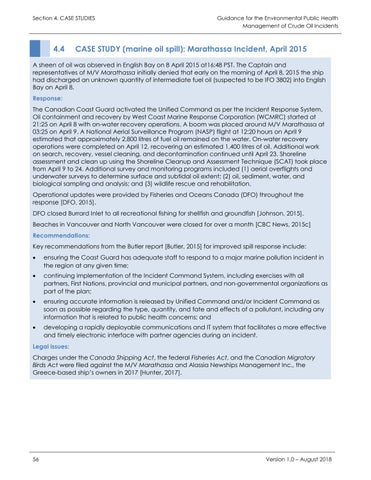Section 4. CASE STUDIES
4.4
Guidance for the Environmental Public Health Management of Crude Oil Incidents
CASE STUDY (marine oil spill): Marathassa Incident, April 2015
A sheen of oil was observed in English Bay on 8 April 2015 at16:48 PST. The Captain and representatives of M/V Marathassa initially denied that early on the morning of April 8, 2015 the ship had discharged an unknown quantity of intermediate fuel oil (suspected to be IFO 3802) into English Bay on April 8. Response: The Canadian Coast Guard activated the Unified Command as per the Incident Response System. Oil containment and recovery by West Coast Marine Response Corporation (WCMRC) started at 21:25 on April 8 with on-water recovery operations. A boom was placed around M/V Marathassa at 03:25 on April 9. A National Aerial Surveillance Program (NASP) flight at 12:20 hours on April 9 estimated that approximately 2,800 litres of fuel oil remained on the water. On-water recovery operations were completed on April 12, recovering an estimated 1,400 litres of oil. Additional work on search, recovery, vessel cleaning, and decontamination continued until April 23. Shoreline assessment and clean up using the Shoreline Cleanup and Assessment Technique (SCAT) took place from April 9 to 24. Additional survey and monitoring programs included (1) aerial overflights and underwater surveys to determine surface and subtidal oil extent; (2) oil, sediment, water, and biological sampling and analysis; and (3) wildlife rescue and rehabilitation. Operational updates were provided by Fisheries and Oceans Canada (DFO) throughout the response [DFO, 2015]. DFO closed Burrard Inlet to all recreational fishing for shellfish and groundfish [Johnson, 2015]. Beaches in Vancouver and North Vancouver were closed for over a month [CBC News, 2015c] Recommendations: Key recommendations from the Butler report [Butler, 2015] for improved spill response include: •
ensuring the Coast Guard has adequate staff to respond to a major marine pollution incident in the region at any given time;
•
continuing implementation of the Incident Command System, including exercises with all partners, First Nations, provincial and municipal partners, and non-governmental organizations as part of the plan;
•
ensuring accurate information is released by Unified Command and/or Incident Command as soon as possible regarding the type, quantity, and fate and effects of a pollutant, including any information that is related to public health concerns; and
•
developing a rapidly deployable communications and IT system that facilitates a more effective and timely electronic interface with partner agencies during an incident.
Legal issues: Charges under the Canada Shipping Act, the federal Fisheries Act, and the Canadian Migratory Birds Act were filed against the M/V Marathassa and Alassia Newships Management Inc., the Greece-based ship’s owners in 2017 [Hunter, 2017].
56
Version 1.0 – August 2018







